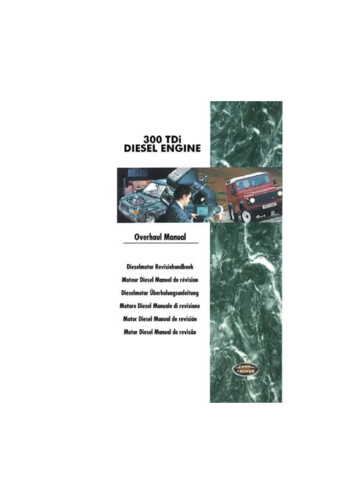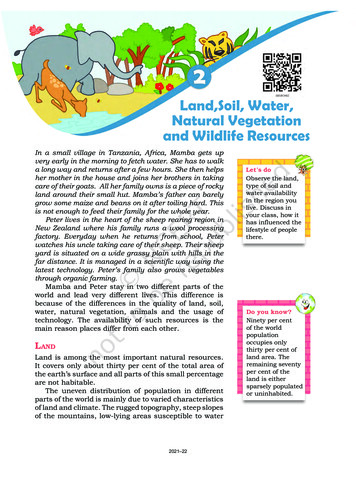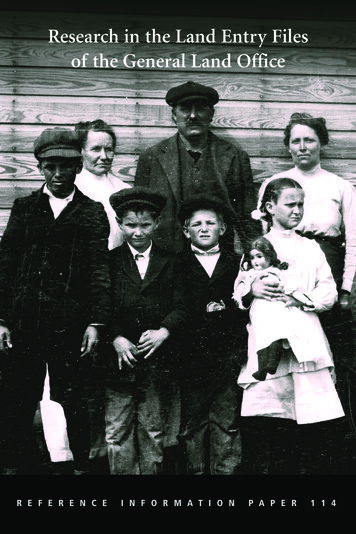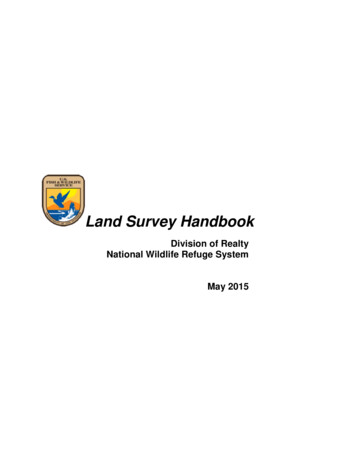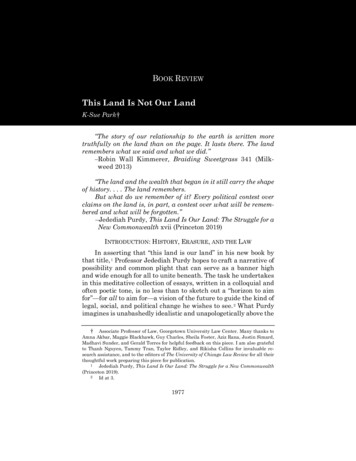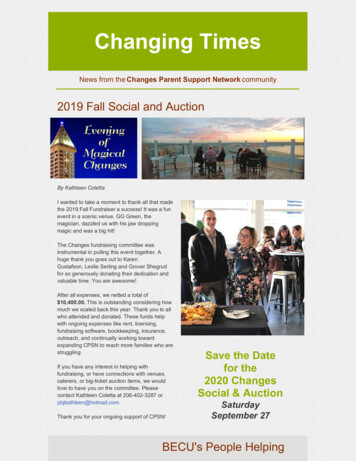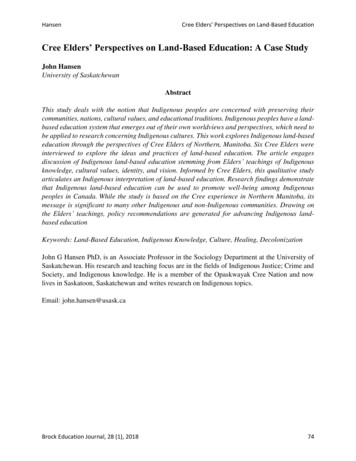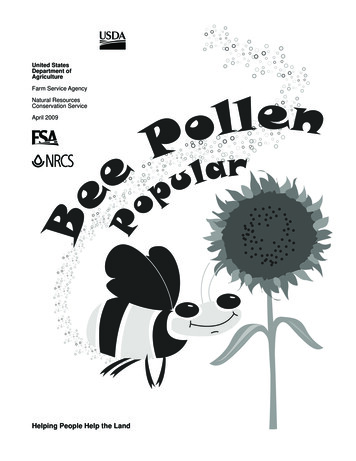
Transcription
United StatesDepartment ofAgricultureFarm Service AgencyNatural ResourcesConservation ServiceApril 2009Helping People Help the Land
Bee Pollen PopularThe Bee and the FlowerPollen is a fine to coarse powder made by plants. The pollen consists of grains carrying male cells. Pollinationhappens when the pollen is moved to a female part of a flower. Most flowering plants rely on nature to movethis pollen around. Without pollination, most flowering plants could not produce fruit or seeds.The PollinatedMany plants rely on bees, butterflies, hummingbirds, bats, moths, flies, and beetles to move the pollen around(pollination). We call special plant helpers, like bees, “pollinators”! Pollinators visit flowers to collect pollen orthe sweet liquid called nectar. As they visit the flowers, the pollinators brush against the reproductive parts ofthe flower, dropping the pollen from another flower they recently visited. About three-quarters of the world’sflowering plants and many of the food crops eaten in North America depend upon pollinators. No pollinationwould mean no apples, blueberries, strawberries, chocolate, almonds, melons, peaches, pumpkins, or manyof the other important foods we love to eat each day. We would also not have plants that are used formedicine to make us feel better.Certain plants that live in Montana actually attract pollinators! Some of these plants include American plum,sunflower, blue elderberry, purple coneflower, chokecherry, columbine, yucca, cherry tree, huckleberry,snowberry, aster, golden currant, and rocky mountain juniper. These plants and many others continue to growand reproduce because of pollinators.Connect the dots to see who’spollinating this 835 361529133373410448111819 2017 21 22261239 53028294262665150667636543Page 257
Bee Pollen PopularThe PollinatorsBees – Bees include bumblebees and honeybees.Bees prefer blue or yellow flowers, like sunflowers,and flowers that smell sweet.Moths – What is the difference between a moth and abutterfly? Generally, the moth only flies at night andhas multiple shapes of antennae. The butterfly fliesduring the daylight and has knobs at the ends of itswiry antennae. Both are attracted to sweet-scentedflowers that are typically large and white or pale incolor, including desert plants like the yucca.Butterflies – Butterflies taste with their feet!Butterflies like flowers that are red, yellow, ororange, like the color of the purple coneflower’scenter. Smell doesn’t matter to butterflies; they relymore on seeing than smelling to find nectar.Flies – Flies can be found on flowers of many colors,usually those that give easy access to nectar.Montana-grown cherries are an example of a plantthat flies help pollinate.Hummingbirds – To survive, many hummingbirdsmust eat twice their body weight in nectar eachday! Hummingbirds are attracted to orange, yellow,or red flowers, like the color of the red columbine.Like most birds, hummingbirds do not have greatsmell features, so they don’t care what the flowersmells like.Wasps – Although wasps are not vital for pollinationin Montana, they still help pollinate the fruit we eat,such as figs and huckleberries.Beetles – Beetles are the oldest pollinators on earthand pollinate many of the most primitive floweringplants, such as the aster. Beetles are typicallyattracted to flowers that are white or green and have awide opening.Bats – Some bats travel more than 1,000 milesevery spring. Bats like flowers that are large andwhite or pale in color. Some bat-pollinated flowersare open only at night. Bats pollinate many fruitcrops, including bananas!Draw a line from eachpollinator to the kind ofplant it likes.beetlehummingbirdsunflowerbutterflypurple coneflowerbatasterred columbinebanana treecherry treewasphuckleberryyuccabeeflymothPage 3
Bee Pollen PopularWhere Are the Pollinators?Look through the pictures on pages 4 and 5 to see if you can find all the hidden pollinators. Find a bee,butterfly, hummingbird, bat, moth, fly, wasp, and beetle! When you find them, color them in.Page 4
Bee Pollen PopularPage 5
Bee Pollen PopularThe Pollen, the Bee, and the HiveHoneybees are fuzzy and carry an electrostatic charge that makes pollen grains stick to their bodies. Sometypes of bees actually carry pollen in a tiny basket located on their hind legs.Wild bees live in hives that usually have only one entrance. The hives are made up of wax called honeycombsthat store honey and house the baby bees, or larva. Bees have many different jobs. Some work inside thehive while others work outside. A beehive has one queen bee thatcreates all the baby bees and is served by hundreds of male beesand thousands of female worker bees that clean the hive, feed thelarva, and gather the pollen.Did You Know?There are 20,000 known species of bees.Honeybees are the only insects that produce food for humans.Bees fly an average of 13 to 15 miles per hour.Queens will lay almost 2,000 eggs a day at a rate of 5 or 6 a minute.Between 175,000 and 200,000 eggs are laid per year.The queen beehas lost herway. Can youguide herthrough thehive?Page 6
Bee Pollen PopularHives and Honey – “Bee” a BeekeeperBeekeepers have the important job of making sure bees have plenty of food and a good “hive” to live in so thebees continue their work making honey and pollinating fruits and flowers.If you decide you would someday like to become a beekeeper, there are a few things you will need to getstarted: a hive (or house) for the bees; bees (buy or collect them from trees and walls); protective clothing(which should be white or tan in color) to keep you from getting stung by the bees; and special tools (toharvest and handle the honey crop). You must keep your hives at least three milesaway from other beekeepers’ hives. Hives should not be placed near homes orchildren’s play areas. Hives do need to be near fresh water and fruit andpollen sources. The best time to start your bee colonies is in the springor early summer.Bee FactsMontana is one of the top 10 honey-producing states in the nation.There are about 200 beekeepers in Montana.Bees raised by at least 36 Montana beekeepers are sent togrowers in California, Oregon, Washington, and other states tohelp pollinate almond, orange, apple, and other crops.Montana beekeepers produced over 9.1 million pounds of honey in 2007with a value of 8.6 million!Honeybees visit about 2 million flowers just to make one pound of honey.All these words havesomething to do withbeekeeping. Find andcircle them in the TYNDLLOGAOKHMTIJPage Q
Bee Pollen PopularThe Disease that Makes Bees DisappearMany bees are getting sick, and scientists are studying possible causes of the illness so, in the future, beeswill be better protected. The disease, called “Colony Collapse Disorder” (CCD), has led to the disappearanceof many bees from beekeepers’ colonies.How do beekeepers know when their bees are getting sick?Unscramble the words onthe left and match themwith the “bee” words on the right. There are not many adult bees left in a hive. There is no build-up of dead bees in the hive(infected bees just disappear). Other bees are not trying to steal food left in a hive.CCD happens very quickly. Over a few days or weeks, most ofan infected colony’s 40,000 or so worker bees leave and die inthe field. Only a queen bee and some newly emerged youngbees remain alive. This is a serious problem, not just for thebees but for all of us, because pollination by honeybees isessential to grow fruit, nut, and vegetable crops around theworld. When the honeybees die, our food supply isdecreased.There is no answer to what causes CCD. Some ideas aboutpossible causes include exposure of the bees to chemicals,infectious germs or viruses, colony stress, or problems withthe biological development of the ntcolonyerwkorWhat we can do to help? We can increase pollinator-friendlyhabitat in our backyards by growing the right plants!deadPollinators Are ImportantIn Montana, native trees, shrubs, forbs, and grasses can, with the proper mix, provide a continuous source ofnectar and pollen needed by pollinators and other beneficial insects. The Natural Resources ConservationService (NRCS) and the Farm Service Agency (FSA), both agencies of the United States Department ofAgriculture (USDA), encourage the planting of native pollinator-friendly plants that:292419 202842yucca17 21 22263231539 40334103437491514835 3657banana tree585259616051686766846265648382cherry red columbineasterpurple coneflower63sunflower8070757978777674737172Answer Keys:Page 86XXTOBLVNJZOXVIS41271211pg. 7pg. 64330252318pg. PEXGUPpg. ONUXFQneqeu queencposelal collapsehyone honeyeeasdis diseaseeadd deadnyocol colonydielf fieldvihe hivelapnt planterwkor worker04/09/MTPreservation of pollinators issupported by both NRCS andFSA in selected conservationprograms.pg. 2 Provide habitat and winter cover for insects Help suppress undesirable weed seeds Provide some biological control of insect and disease pests Reduce the risk of soil erosion Provide food and shelter for native wildlife speciesUSDA is an equal opportunity provider and employer.
or red flowers, like the color of the red columbine. Like most birds, hummingbirds do not have great smell features, so they don’t care what the flower smells like. Bats – Some bats travel more than 1,000 miles every spring. Bats like flowers that are large and white or pale in c


